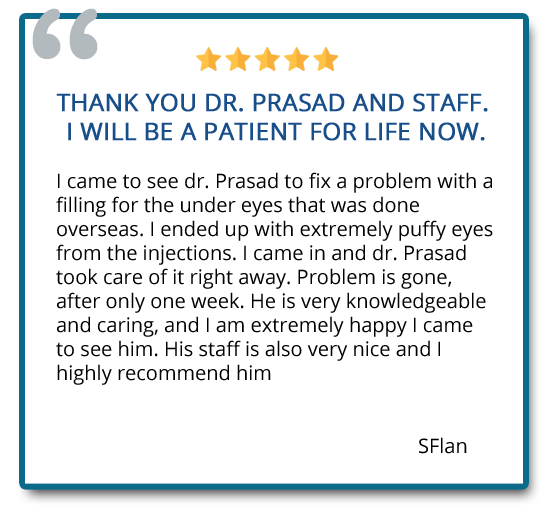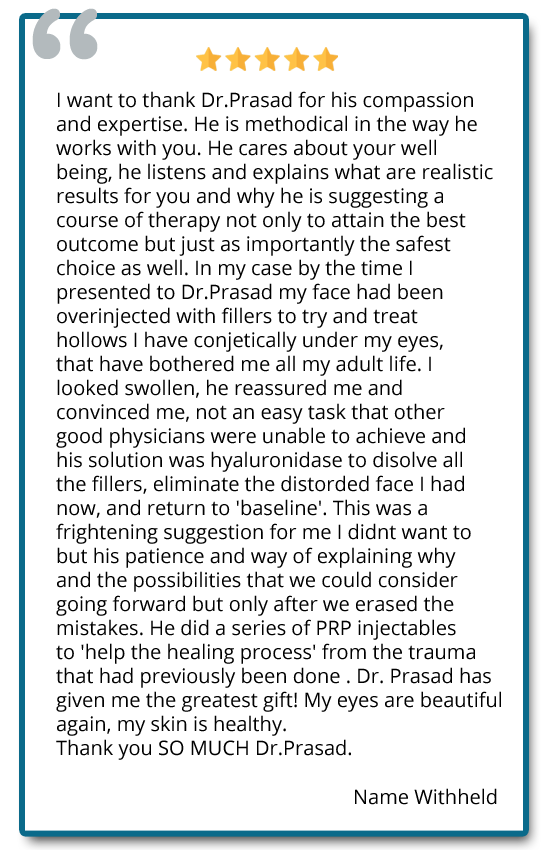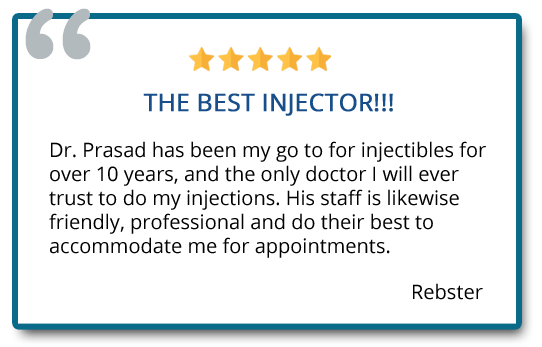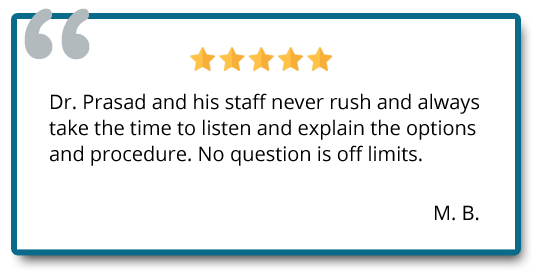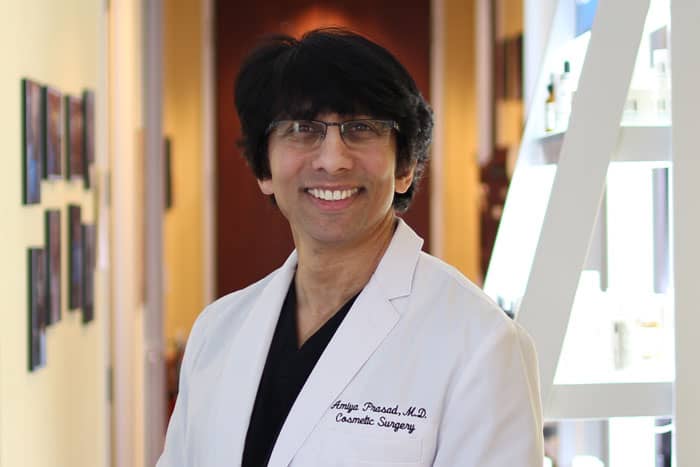Schedule Your Consultation with Dr. Prasad Here
- Home
- About Dr. Prasad
- Face & Eyes
Eyelifts
- Eyelid Surgery NYC
- Eye lift Before and After Photos
- Asian Eyelid Surgery
- Upper Eyelid Surgery
- Upper Eyelid Hollow / Lower Brow Hollowing
- Under Eye Bag Surgery
- Eyelid Ptosis Surgery
- Transconjunctival Blepharoplasty
- Under Eye Fillers
- Eyelid Surgery Revision Specialist
- Thyroid Eye Disease
- Tear Trough Implants
- Eye Lift Questions and Answers
- Body
- Injectables
- Laser
- Hair Restoration
- Photos
- Hair Restoration Before and After Photos
- Eye lift Before and After Photos
- Upper Blepharoplasty Before and After
- Ptosis Surgery Before And After
- Facelift Before and After Photos
- Lip Enhancement Before and After Photos
- Under Eye Filler Before and After
- Blepharoplasty Before and After
- Lower Blepharoplasty Before and After Photos
- Eyelid Surgery Before and After
- Double Eyelid Surgery Before and After
- Contact Us
- Home
- About Dr. Prasad
- Face & Eyes
Eyelifts
- Eyelid Surgery NYC
- Eye lift Before and After Photos
- Asian Eyelid Surgery
- Upper Eyelid Surgery
- Upper Eyelid Hollow / Lower Brow Hollowing
- Under Eye Bag Surgery
- Eyelid Ptosis Surgery
- Transconjunctival Blepharoplasty
- Under Eye Fillers
- Eyelid Surgery Revision Specialist
- Thyroid Eye Disease
- Tear Trough Implants
- Eye Lift Questions and Answers
- Body
- Injectables
- Laser
- Hair Restoration
- Photos
- Hair Restoration Before and After Photos
- Eye lift Before and After Photos
- Upper Blepharoplasty Before and After
- Ptosis Surgery Before And After
- Facelift Before and After Photos
- Lip Enhancement Before and After Photos
- Under Eye Filler Before and After
- Blepharoplasty Before and After
- Lower Blepharoplasty Before and After Photos
- Eyelid Surgery Before and After
- Double Eyelid Surgery Before and After
- Contact Us
Under Eye Fillers:
Treatment for Hollow Eyes, Tear Troughs, and Slight Eye Bags
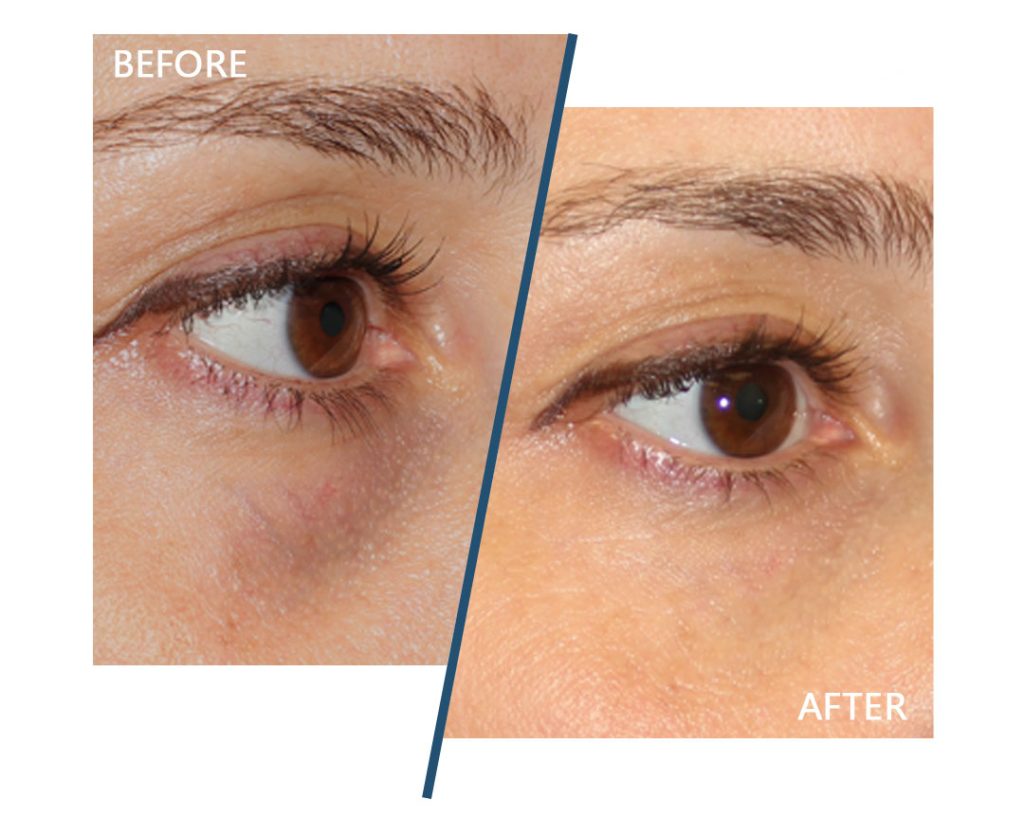
Softer cosmetic fillers offer a lot of versatility for issues under the eyes, from: hollowness, deep tear troughs, and even slight under eye bags.
What Causes Under Eye Hollows?
The under eye area may have a hollowed look due to:
- genetics
- volume loss due to aging
- from environmental and health factors such as excessive sun exposure, or
- habits such as cigarette smoking that can affect the skin internally and externally.
Hollowness can affect the whole under eye area all the way to the upper cheeks, or just the small area directly below the eyes called the tear trough.
What is the Best Hollow Eyes Filler?
Hollow eyes can be effectively treated with a softer hyaluronic acid filler such as Restylane-L, Restylane Silk, or Juvederm Ultra to enhance volume. New fillers continue to be developed which can also be useful. A softer filler is appropriate as lower eyelid skin is the thinnest in the body at 0.5mm of thickness, and can move flexibly with facial expressions –
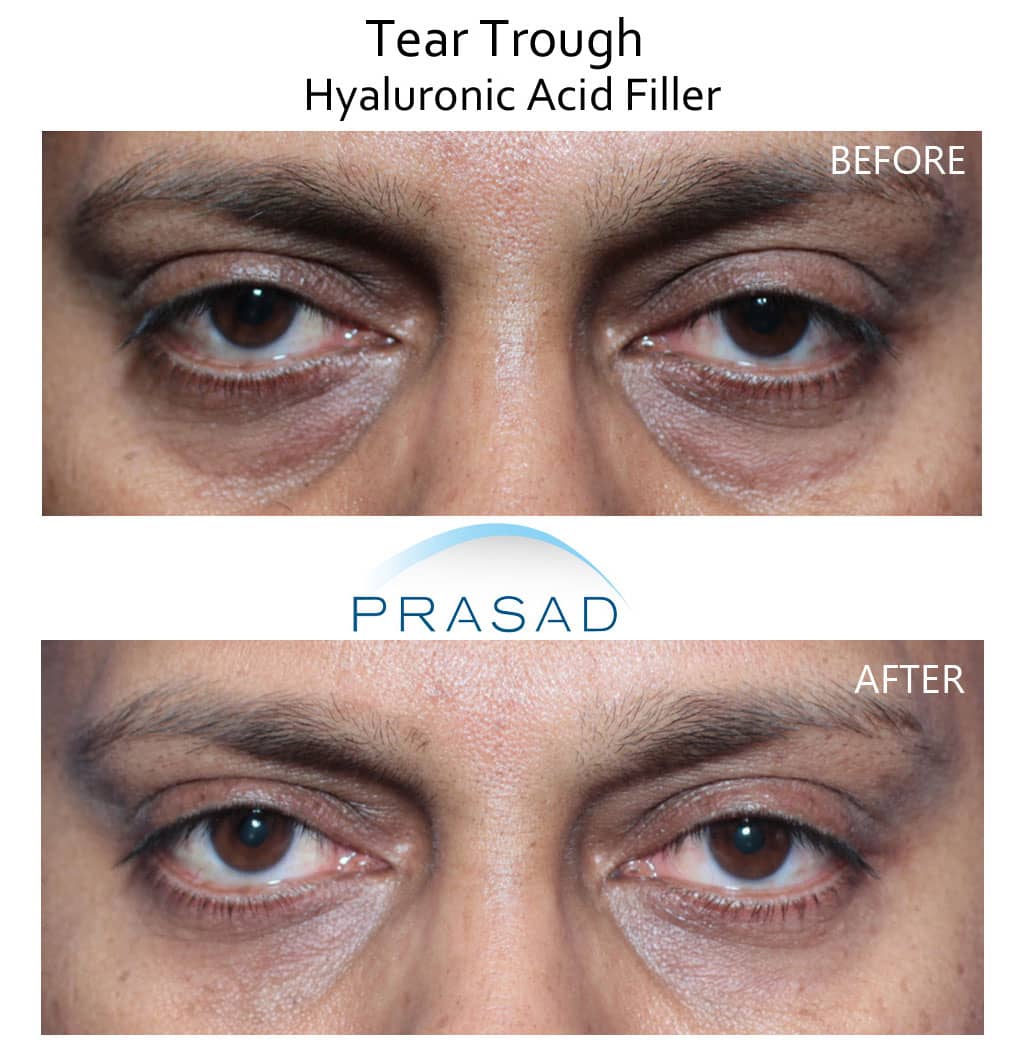
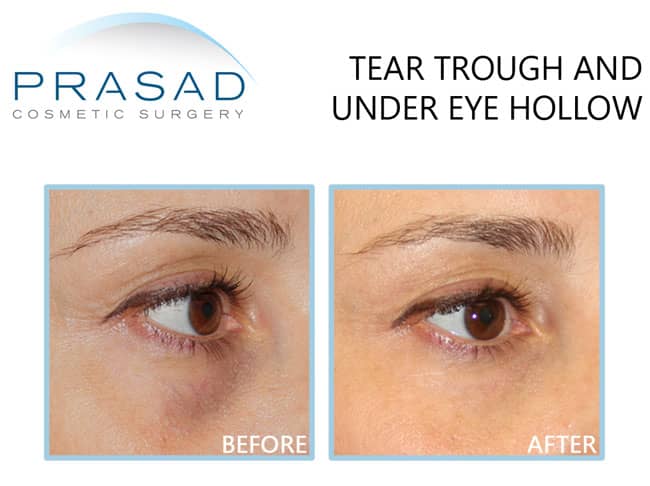
softer hyaluronic acid fillers don’t affect the movement of the eyes and eyelids like thicker fillers, or tear trough implants. The more malleable filler is also more easily molded and customized to fit an individual’s unique space under the eyes. Hyaluronic acid occurs naturally in the body, so hyaluronic acid fillers are safely metabolized with time, and are hypoallergenic.
Under Eye Filler Procedure
The whole procedure, and any additional touch-ups can be performed in just a few minutes. Dermal filler for sunken eyes or hollow eyes treatment should be relatively painless, or at most feel a little pinch with the injection as a topical anesthetic is normally used.
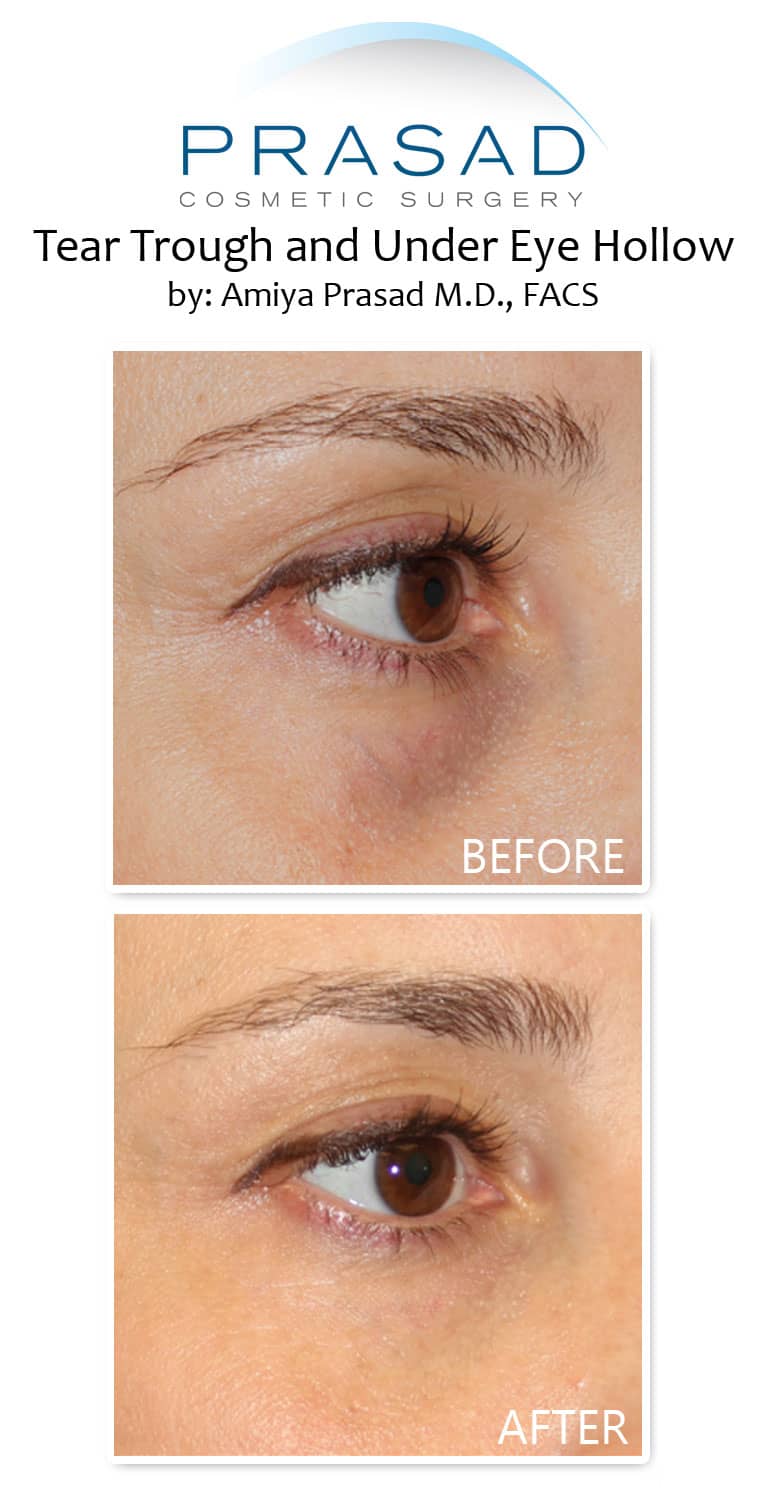
How long does under eye filler last?
Injectable cosmetic fillers like Restylane-L, Restylane Silk, and Juvederm Ultra typically last about a year, depending on how individual patients metabolize the material. Some of our patients enjoy results for up to 18 months, while others find the effects diminish after 6 months. It’s important for you to understand the variability in longevity, and plan for potential touch-up appointments.
A particular benefit of using a hyaluronic acid filler is that if the need arises, the procedure can be reversed. Hyaluronic acid fillers can be dissolved with the enzyme hyaluronidase for complete reversal, and safe absorption by the body.
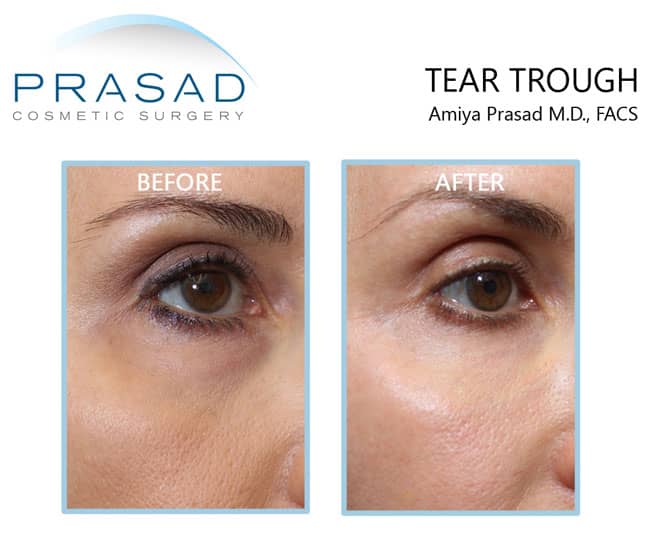
Under Eye Fillers Before and After
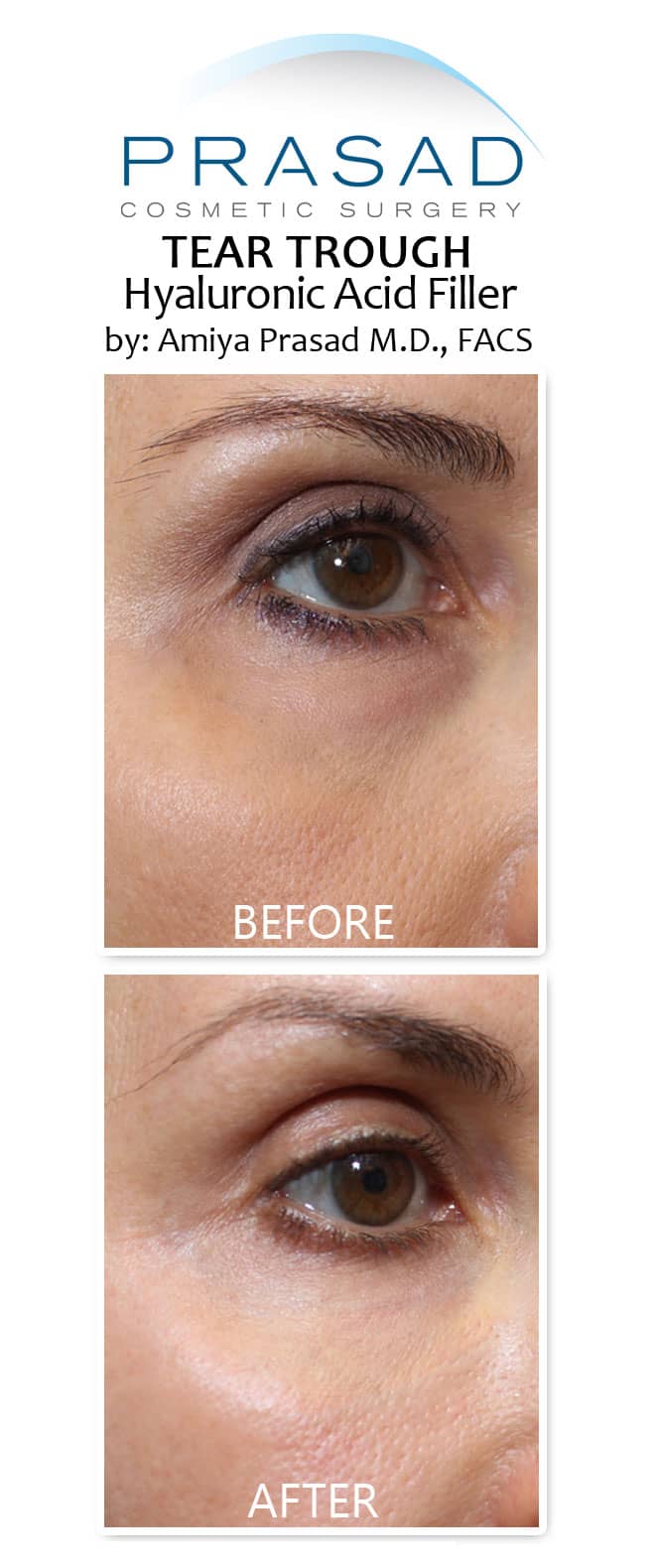
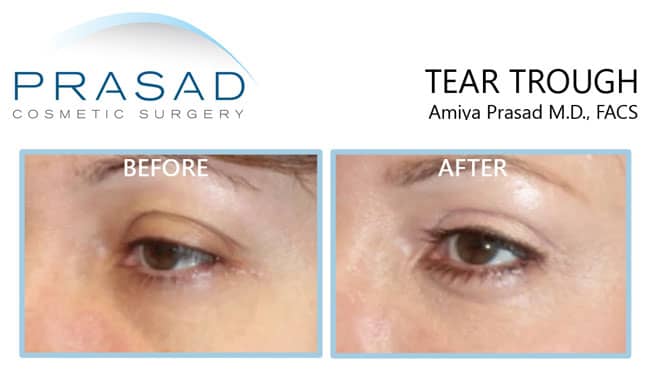
Recovery Time and Process
While it doesn’t usually occur in Dr. Prasad’s hands, swelling or bruising of the under eye area is commonly seen after injectable filler treatment for eye bags. Bruising is temporary, and can last about a week. Similarly, recovery from transconjunctival blepharoplasty done under local anesthesia also lasts about a week. The difference here is that blepharoplasty to remove eye bags can last for years. While hollow eyes filler treatment or sunken eyes filler treatment will need to be repeated, recovery from bruising may need to be repeated as well.
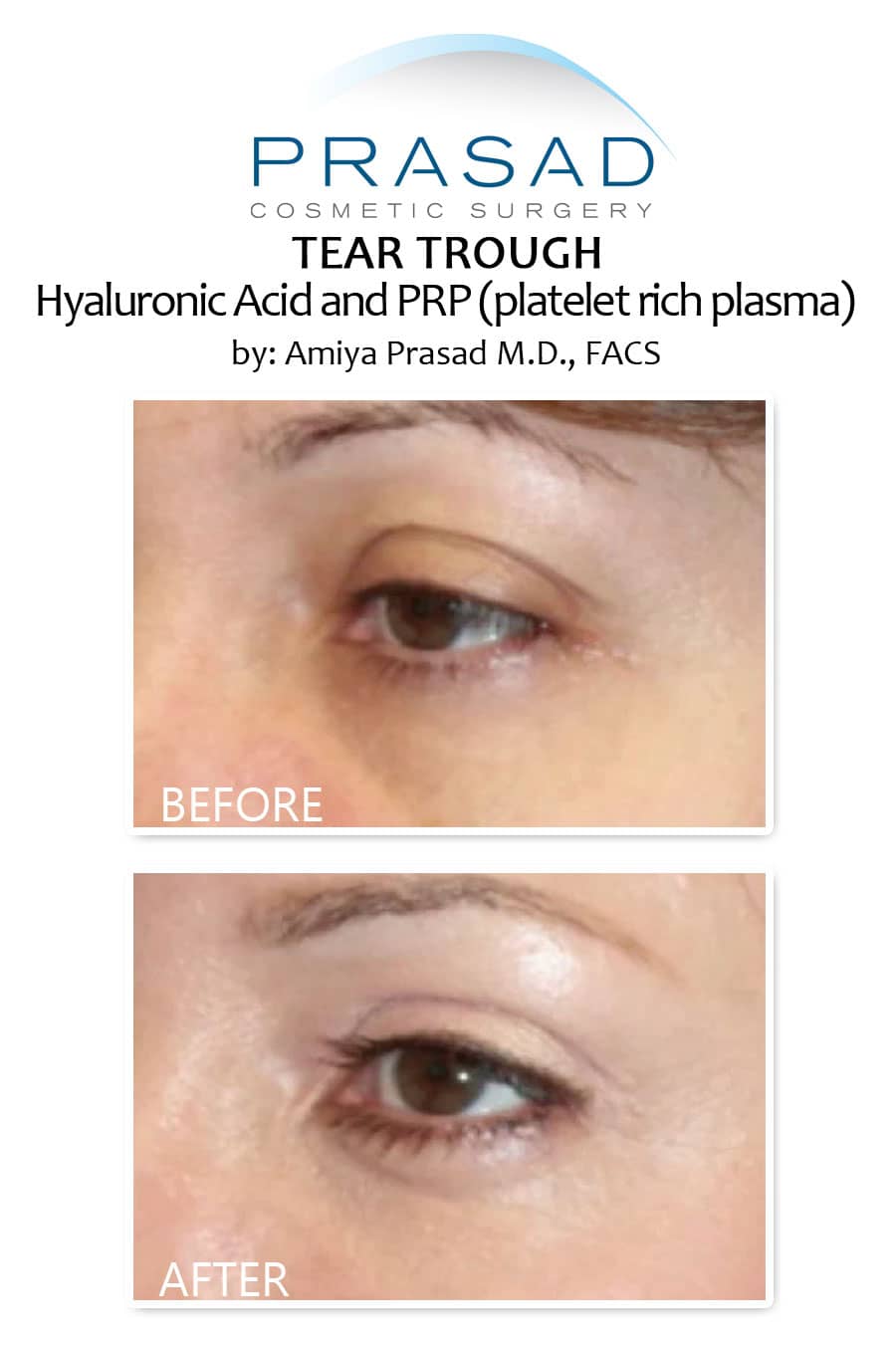
Cost
The cost of under eye filler varies depending on the type of filler used, how much the doctor or practitioner uses, cost of living in your area, and the skill and experience of the doctor performing the treatment. While you can find under eye filler for less at some clinics, it is always best to see a well-experienced doctor or surgeon to perform the procedure—even if it costs a little more. An experienced doctor knows the under eye, and eye area well, so they can avoid potential complications like injecting the filler into an artery (vascular occlusion) and can take the immediate steps in addressing the complication, if it occurs.
For your specific concerns, you can contact us.
Platelet-Rich Plasma (PRP) + Under Eye Filler for Dark Circles
Dr. Prasad often combines a cosmetic filler with platelet-rich plasma (PRP) under the eyes. This creates a synergistic benefit of improving skin quality, color, volume, and also to potentially extend the effect of the filler. Platelet-rich plasma is derived from the patient’s own blood, which is spun down to separate red blood cells.
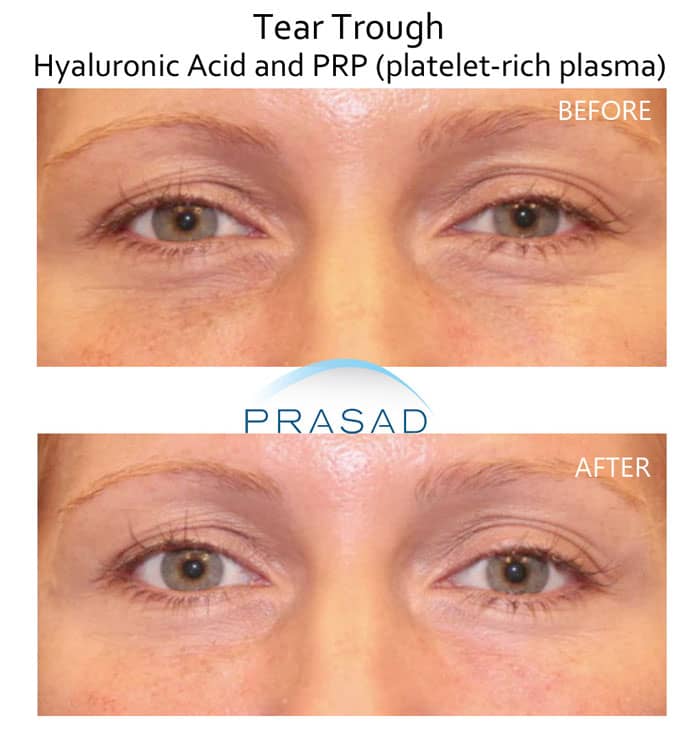
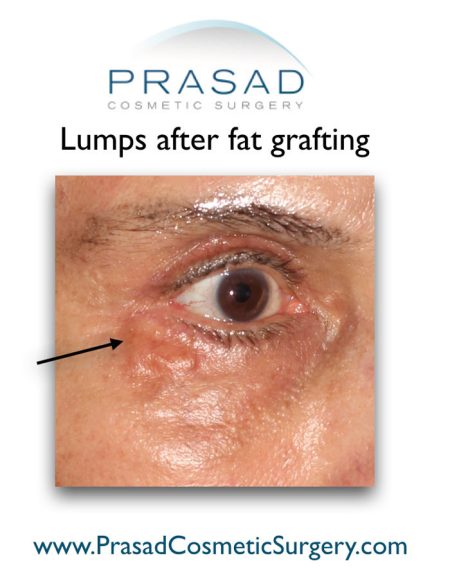
The remaining concentrated plasma contains various growth and healing factors which are important to heal cuts and wounds. The concentration of these growth and healing factors stimulate collagen, help create new blood vessels, improve circulation, improve skin thickness, and add a little volume. PRP improves the quality and health of lower eyelid skin affected by pigmentation issues, and iron deposits that cause discoloration.
Why Fat Transfers are Not Recommended in Lower Eyelids
There is a perception that lower eyelid hollowing is best treated with transferring/grafting a person’s own fat. This perception is understandable as fat is already part of a person’s anatomy. However, transferring fat is deceptively complex and unpredictable for several reasons.
Grafted fat is a texturally inconsistent material once it is removed from its original blood supply, so lumps, bumps, and discoloration are likely issues which can be seen through thin eyelid skin.
Fat also needs to be transferred to a readily available blood supply in the area, so if the fat does not heal as intended, removing it is an intricate and costly procedure.
Fat can also be quickly absorbed by the body, as anywhere from 30-70% of grafted fat may be lost due to absorption, making an additional volume enhancement procedure necessary. Fat grafting is a double surgical procedure: one to harvest the fat, and one to place it. “Touch ups” due to fat absorption require more surgical fat grafting procedures. Removal of transferred fat due to complications is an extensive and expensive surgical procedure. This is in comparison to dissolution of hyaluronic acid filler which takes minutes, and does not require surgery.
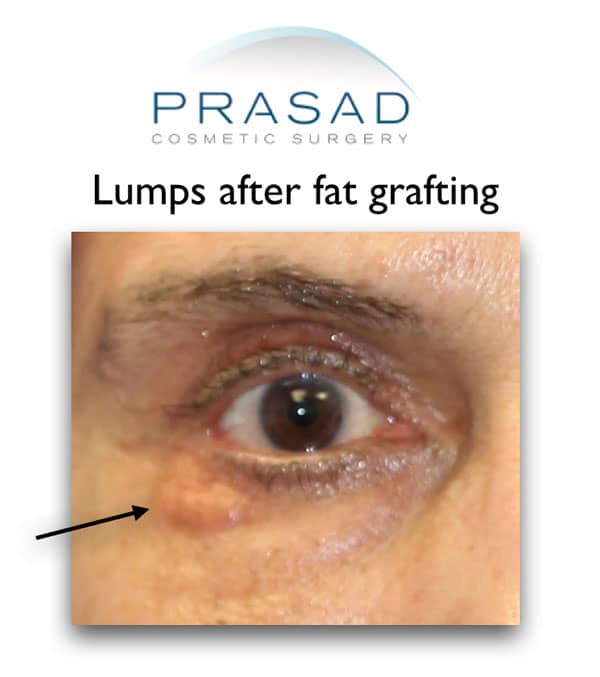
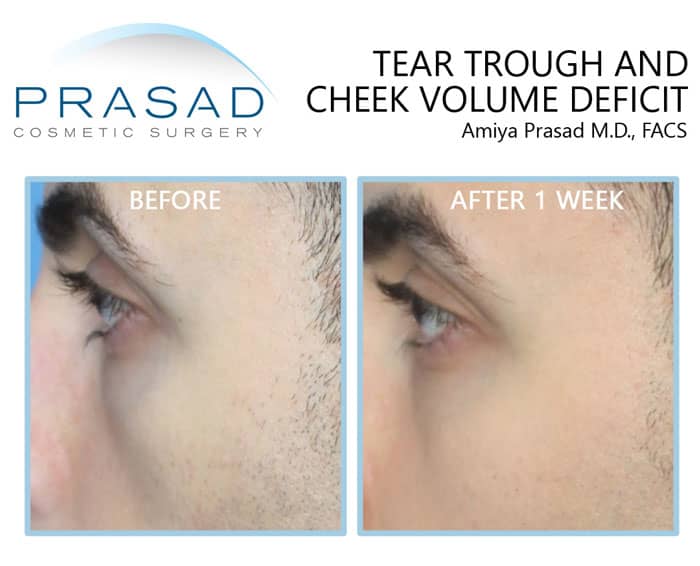
Under Eye Hollowing can also be Caused by the Cheeks
Some cases of hollow under eyes or sunken eyes, and asymmetry between both sides of the face may not be due to hollow tear troughs, but from volume deficiency in the upper cheeks. The upper cheeks can have a volume difference from natural asymmetry of one side from the other, or from volume loss due to aging. In such cases, adding volume with a filler at the tear trough may not be enough and can be problematic as there is no “shelf” of the upper cheek to support the volume.
Volume deficiency at the upper cheek is treated differently than the tear trough. Skin at the cheek is much thicker than thin eyelid skin, and the cheek is also backed by the more rigid cheekbone. A thicker hyaluronic acid filler such as Juvederm Ultra Plus or Juvederm Voluma can be used in the cheeks. These thicker fillers for the cheeks also last much longer than tear trough fillers – up to 1-2 years, respectively.
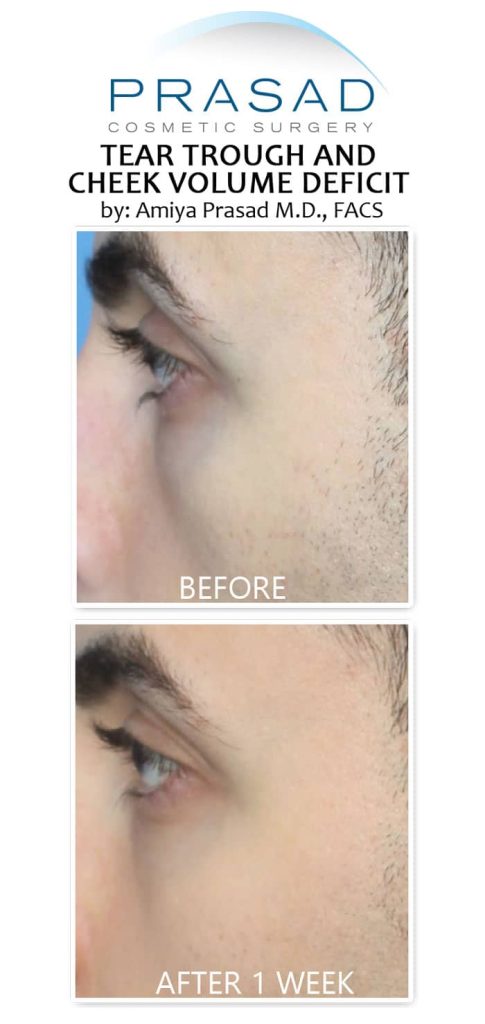
A specialized technique of placing fillers at the cheeks and other facial areas is called Structural Volumizing or the Y Lift® method. Structural Volumizing places long-lasting fillers at the bone level to address bone loss due to aging, providing foundational volume.
This is in stark contrast to fillers normally placed in soft tissue, which may not support the weight of the filler, resulting in the material weighing down the face, or resulting in a doughy or pillowy appearance. With the strong foundation of bone and held in place by the facial muscle layer, Structural Volumizing adds definition and youthful fullness, with natural looking results. More filler volume can be placed with Structural Volumizing than traditional filler placement. The weight sits atop the bone structure, and muscle retains the desired shape far better than fat and soft tissue.
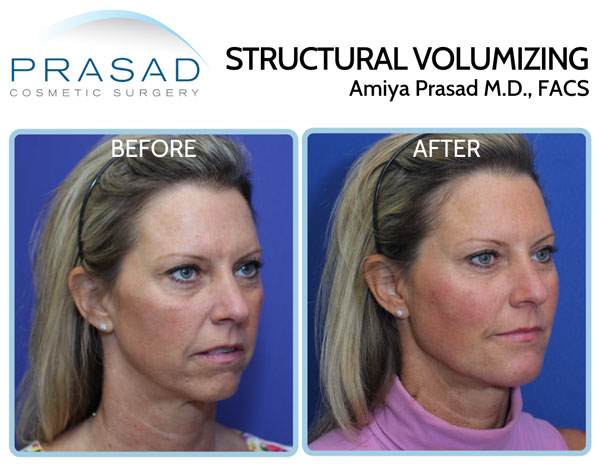
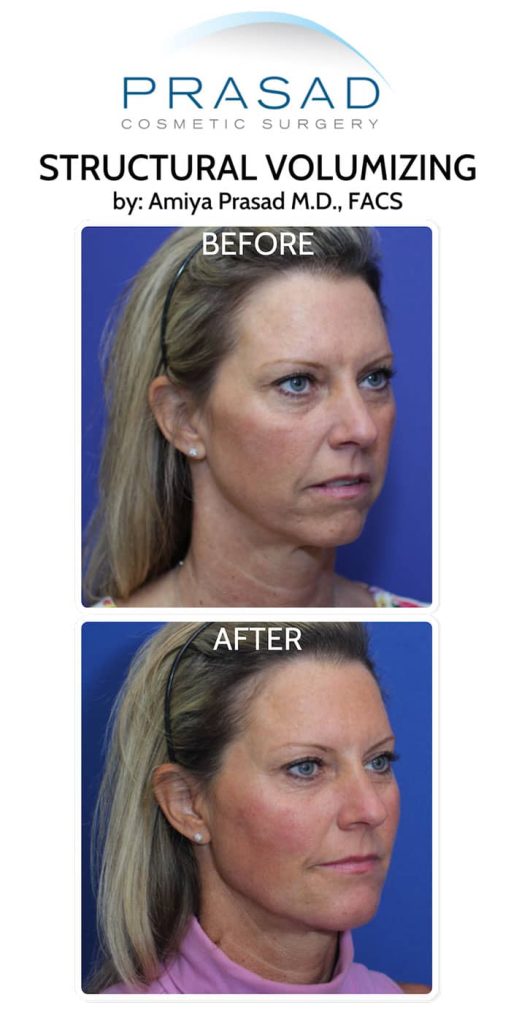
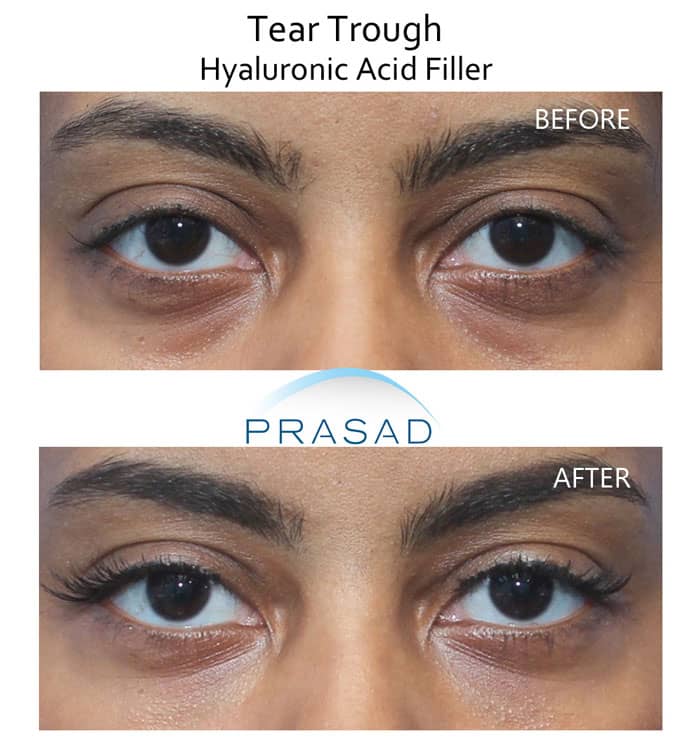
Under Eye Fillers for Eye Bags
Cosmetic fillers to treat under eye bags is one of the most sought treatments in cosmetic medicine. Its popularity is due to eye bags being one of the most common aesthetic issues. Under eye bags are most frequently due to genetics, as well as aging, so many young people do have them. The most common complaints of young people about eye bags are they make them seem more tired, weary, and older than they actually are. Fillers are most often sought to treat eye bags because it is quite typical to be their first ever cosmetic procedure.
Who is not a candidate for under eye filler?
Eye bags can be treated without surgery using injectable fillers, but only in cases where the eye bags are slight. This may go against recommendations of other doctors who may say that almost any case of eye bags can be addressed with filler. As a specialist of the eyelids, Dr. Prasad frequently counsels his patients that fillers are not appropriate for all eye bags cases. Fillers can paradoxically add more volume to the under eye area where fat is already causing large eye bags, so an attempt to camouflage the puffiness with more filler volume often makes the situation worse.
Slight cases of eye bags can be treated by blending the hollow tear trough with the adjacent puffiness under the eyes. A hollow tear trough can make eye bags appear larger. Think of the hollow tear trough as a valley, while the eye bags are a mountain next to the valley. By filling the depth of the valley with a filler, the mountain next to it won’t appear so large. However, with larger eye bags, attempting to add filler to camouflage it can make the under eye area look more voluminous, and will likely make the eye bags appear even larger than prior to treatment.
As an eyelid specialist surgeon, Dr. Prasad often sees cases of overfilled under eyes by other doctors or practitioners, so he frequently dissolves the hyaluronic acid filler with the enzyme hyaluronidase. From there, he decides if the eye bags can still be blended with filler, or if the fat causing the eye bags requires surgical removal.
Fillers to Correct Volume After Eye Bag Surgery
It is crucial to leave some of the orbital fat during eye bag surgery to prevent a hollow appearance. However, even if eye bag removal surgery was executed well, with a nice contour, adjacent areas may still appear hollow.
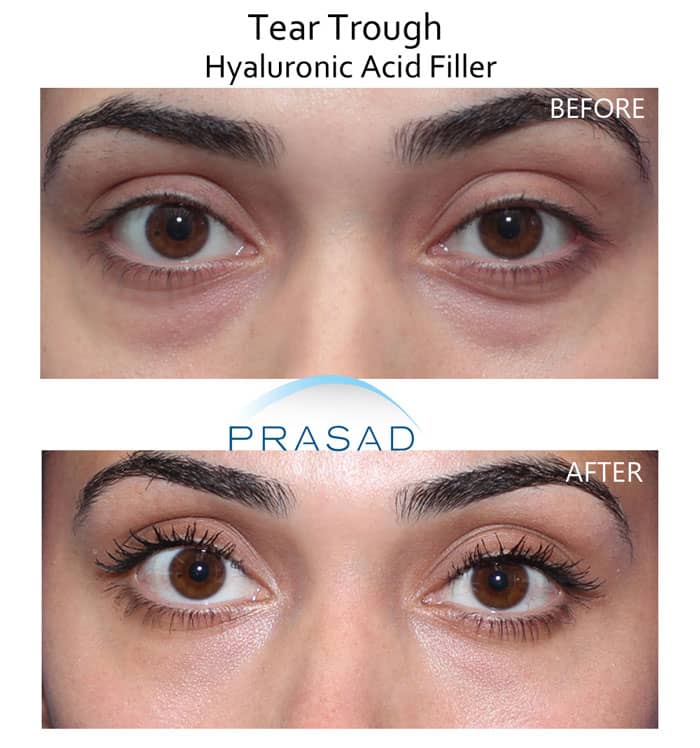
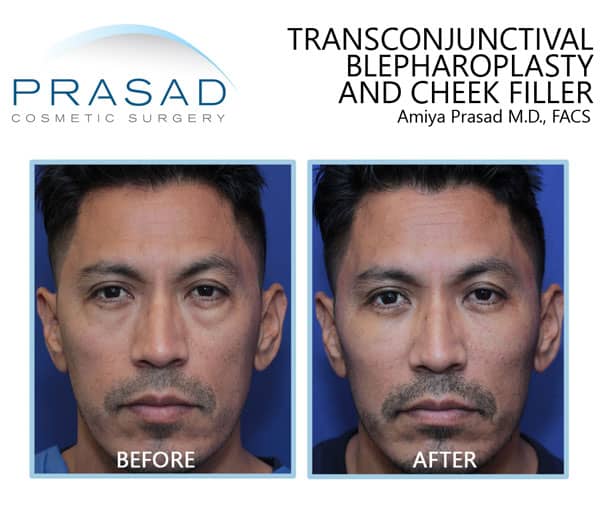
Adjacent areas may include the upper cheeks (eyelid-cheek conjunction), or hollowness at the orbital rim of the eye socket. In these cases, an injectable filler can be used to improve the adjacent hollowness. These include a thicker filler at the upper cheek, or a softer filler at the orbital rim and tear trough.
Considerations for Eye Bags Surgery or Filler Treatment
Fillers are Not Permanent and Do Need Maintenance
While slight eye bags can be treated with filler, it is important to know that maintenance will be needed. Hyaluronic acid fillers are safely broken down by the body, so there is no actual danger.
Since fillers used in the under eye area are softer and less viscous, they also do not last as long as thicker fillers. Expect filler treatment for under eye bags to be repeated every year. In contrast, removing eye bags surgically can last anywhere from years, decades, or can last permanently.
Expectations and Post-treatment Care
- Immediately see the results: Following under-eye filler treatment, you can often see immediate improvement. Filler provides volume and plumpness into the under eye area, minimizing hollowness and tired appearance. It can even camouflage slight eye bags caused by aging, genetics, or lifestyle factors.
- Quick and convenient: The procedure itself is a quick and convenient option with minimal downtime. Patients who often have eye filler treatment done during their lunch hour, then return to work. Most patients see an immediate positive change after their appointment, requiring no further post-care treatment.
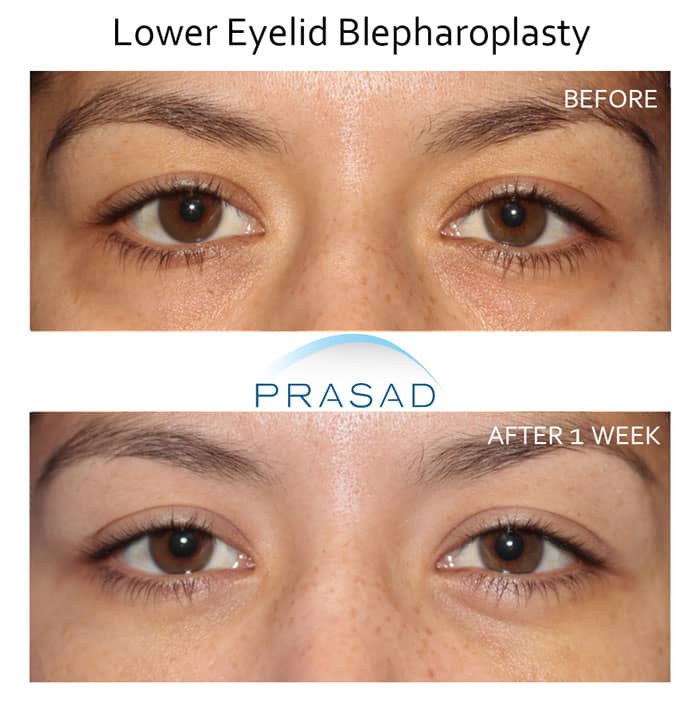
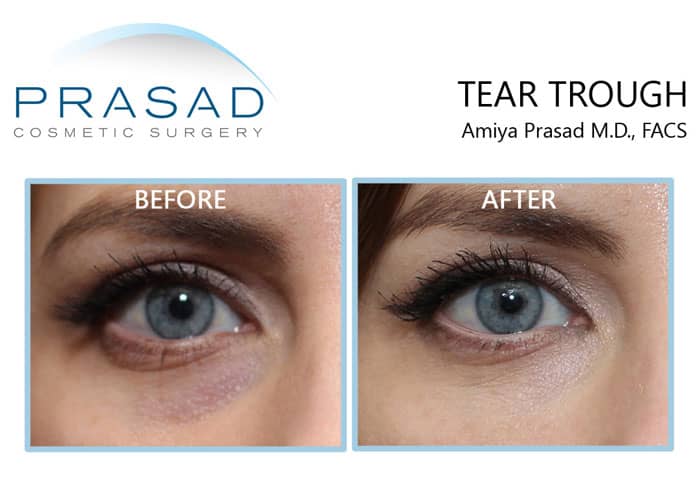
However, I still see patients two weeks after filler treatment to see how the material has settled, and if any further enhancement may be needed for best results.
- Combined options for enhanced results: In some cases, under eye filler treatment can be combined with other procedures for amplified results. For example, PRP (platelet-rich plasma) may be used alongside hyaluronic acid fillers to improve skin quality, skin thickness, increase blood supply, and clear iron deposits to treat dark circles and tired-looking eyes.
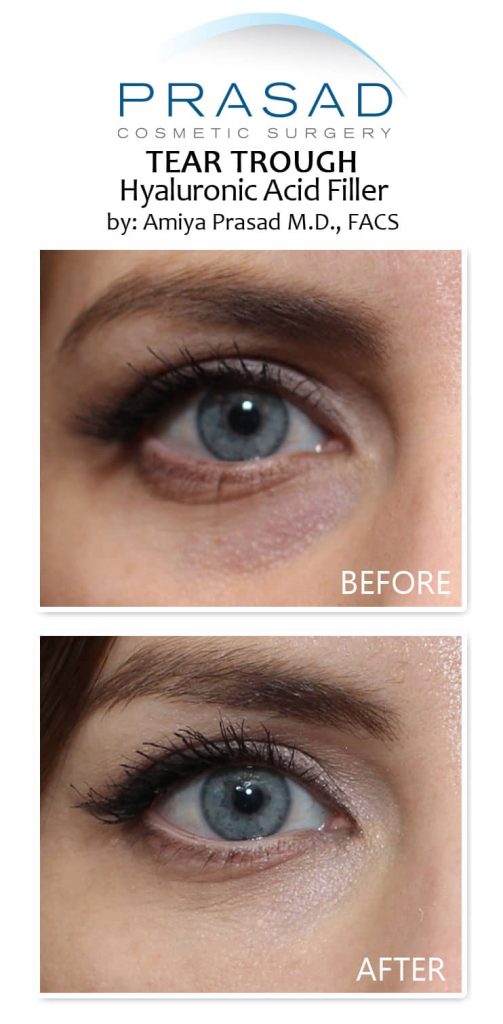
Potential Side Effects of Hyaluronic Acid Fillers are Rare
Hyaluronic acid fillers are generally safe but potential side effects can occur in certain people. Hyaluronic acid is hypoallergenic since it naturally occurs in the body, but there are very rare incidents of allergic reactions. Hyaluronic acid fillers are generally safely metabolized by the body over time, without any foreign body reactions. However, it is possible for hyaluronic acid filler to become encapsulated within the body, preventing metabolization. This can be solved with the injectable enzyme hyaluronidase, which can dissolve the encapsulated filler.
Can under eye fillers go wrong?
Complications from under eye filler treatment are most often associated with practitioners with insufficient training or experience.
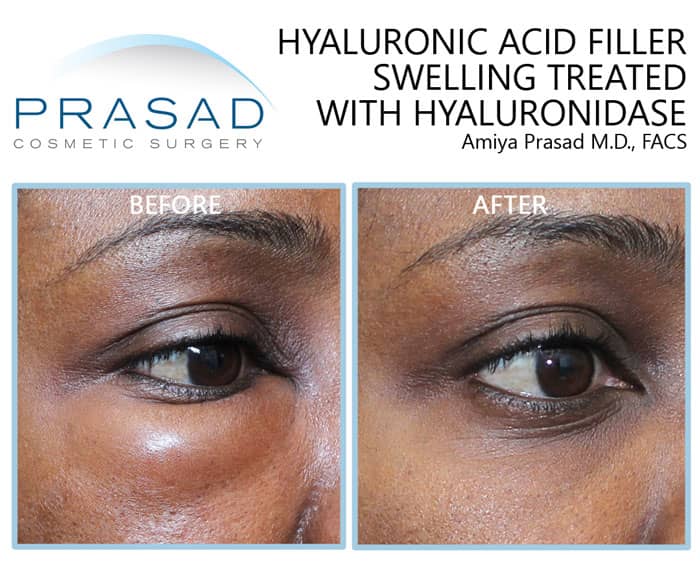
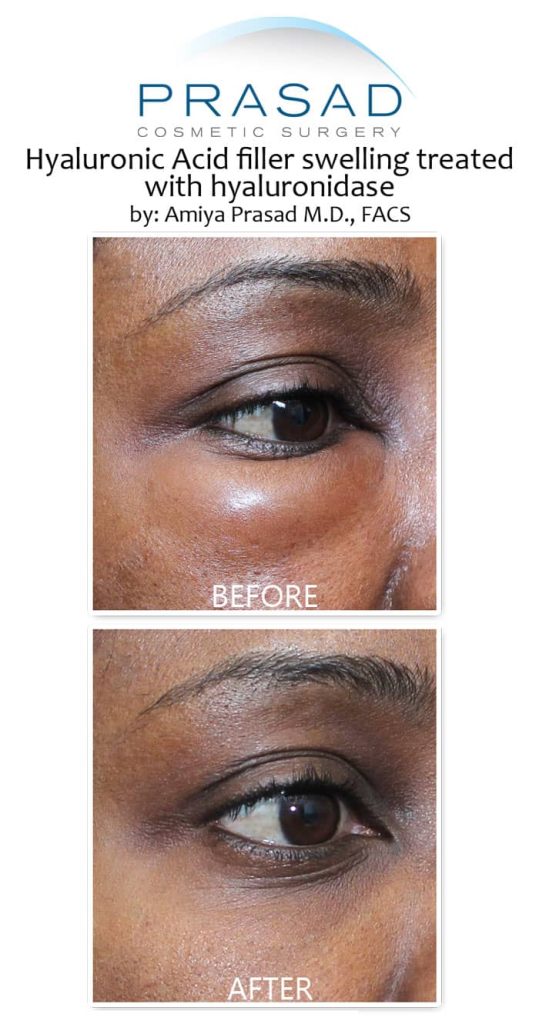
These side effects may include swelling, lumps, or irregularities in the treated area. Therefore, choosing a highly trained and experienced provider is crucial to ensure optimal results and minimize the risk of complications.
Other possible complications include infection in filler placement from skin surface bacteria (biofilm). This has more to do with unsterile conditions than from the filler material, with surface bacteria entering through the needle rather than the filler material.
Any medical procedures involve risks, but risk can be minimized by having a highly-trained and experienced doctor. Although it is rare, filler can be injected into a blood vessel or artery causing blindness (vascular occlusion).
Incidence of complications, and addressing them immediately as they occur are advantages of having under eye fillers administered by the specialty level of, or comparable to an oculoplastic surgeon. Read what to do when under eye fillers gone wrong
Do Under Eye Fillers Help with Wrinkles?
Under eye wrinkles are treated by improving lower eyelid skin quality. This may include regenerative treatments such as platelet-rich plasma (PRP) or precision heating devices such as lasers or radiofrequency technology used to stimulate the body’s collagen production. Read Under Eye Wrinkle Treatment Options
What is the best filler for under eyes?
The safest material to use is filler made of hyaluronic acid. Hyaluronic acid is naturally present in the body, so there are no issues with tolerance or foreign body reactions. Hyaluronic acid fillers are safely metabolized with time. If someone doesn’t like the results of their under eye filler treatment, they can have the filler dissolved with injectable enzyme hyaluronidase.
It’s important to keep in mind that the doctor, not the material, determines the results of filler treatment. The results of filler treatment, and minimizing risks of complications are determined by the experience, expertise, and aesthetic style of the doctor. Think of the filler material as clay for a sculpture, and the doctor as the sculptor.
Under Eye Filler NYC and Long Island, New York
Dr. Amiya Prasad is a Board-certified cosmetic surgeon, and a Fellowship-trained oculofacial plastic and reconstructive surgeon practicing in New York City, and Long Island for over 25 years. To find the best treatment for your under eye problems, a proper physical evaluation is necessary.
Contact us by filling out the contact form below, and we’ll get back to you. You may also reach us in Manhattan, New York City at (212) 265-8877. Or Garden City, Long Island at (516) 742-4636; or Vienna, Virginia at (703) 356-1336.
Patient Reviews on Under Eye Fillers


